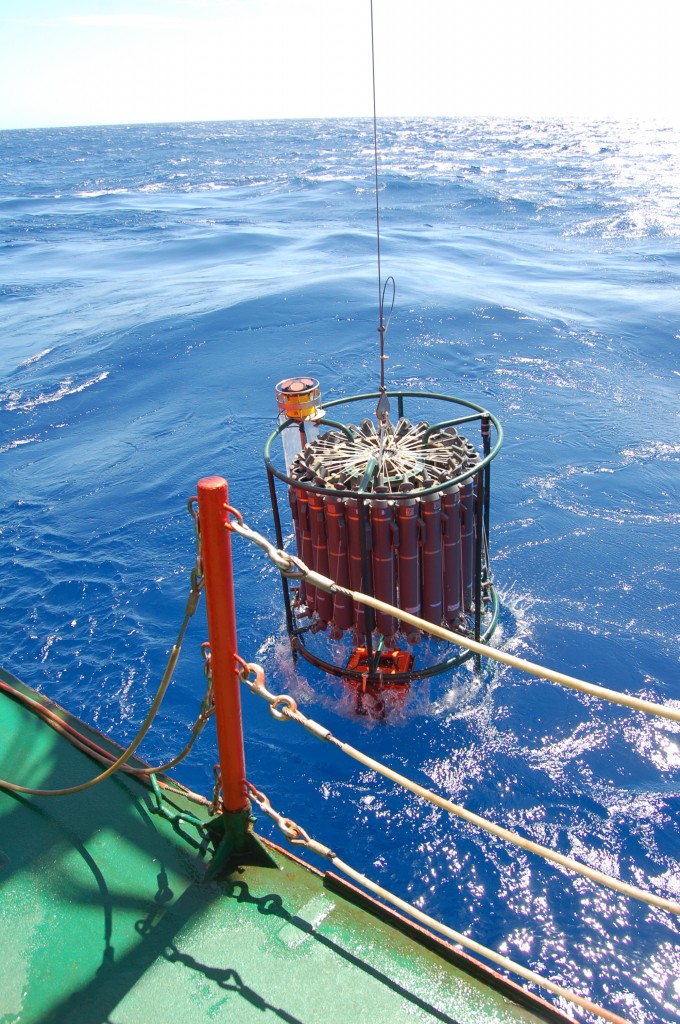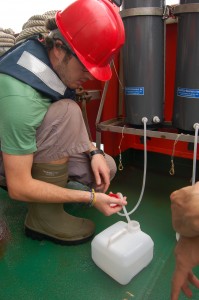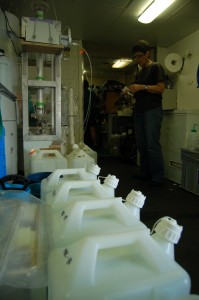S 34° 33’ 51″ E 31° 01’ 48″ – Every day around dawn the Hespérides pauses in its 5,000 nautical mile journey. It does not begin again until mid-afternoon, when its researchers have slaked their thirst for samples with a bewildering variety of bottles and nets. Yet every day scientists ask one another a mysterious question: “Can I have some of your water, please?”

A little after 8:30pm each evening in the scientists’ lounge, chief scientist Jordi Dachs discusses the next day’s schedule. There are more scientists than seats, so some lean with tired legs against the walls or bunkroom doors as the ship rolls and pitches. But almost none miss the briefing, since it is the final confirmation of when each scientist must arrive on deck to supervise their data collection or pick up their share of a water sample.
The stakes are high. If a sampling supervisor fails to arrive 15 minutes before that sample’s assigned time, Dachs warns, he may skip their sample and move on to the next. And if a scientist entitled to 450 millilitres of water from a particular depth is not on hand when the supervising scientists empty the sampling bottle, that water may end up in another scientist’s plastic jug, or just splash back on the deck and wash out overboard.
 A handful of daily instruments feed the scientists’ voracious need for water, but mechanical obstacles can come between them and satisfaction. For example, on Monday a winch used to lower the sampling rosetta nearly let the rosetta hit bottom and now Dachs has decreed a larger buffer between the deepest sampling point and the seafloor, which is deeper than 4,000 metres in these parts. The team lost time and data while technicians and navy mechanics worked on the winch.
A handful of daily instruments feed the scientists’ voracious need for water, but mechanical obstacles can come between them and satisfaction. For example, on Monday a winch used to lower the sampling rosetta nearly let the rosetta hit bottom and now Dachs has decreed a larger buffer between the deepest sampling point and the seafloor, which is deeper than 4,000 metres in these parts. The team lost time and data while technicians and navy mechanics worked on the winch.
As a backup, other scientists dipped larger sampling bottles in shallower waters, which sated scientists studying how light affects the metabolism of the sea’s smallest near-surface inhabitants but did little for those interested in deep sea genetics or carbon cycling. It also threw off the normal chain of distribution, since the people who handle the large sampling bottles are not the same as those who handle the sampling rosetta.
Scientists themselves are also prone to mechanical failures that can throw off their experiments. Iñigo García, a graduate student at the CSIC’s Mediterranean Institute of Advanced Studies (IMEDEA) in Mallorca, came down with an upset stomach early last weekend before we’d even begun work. The normally ebullient graduate student was unable to handle his sampling responsibilities. But he seemed fresher at breakfast Tuesday morning and later bounced into one of the biogeochemistry laboratories to ask for deep sea water.
Celia Marrasé Peña, of the CSIC´s Institute of Marine Science in Barcelona, narrowed her eyes and asked him why he needed it. She was cleaning a filter, surrounded by over a dozen white 20-litre jugs of water taken that morning from 3,900 metres depth.
“They weren’t counting on my sudden recovery,” García explained,  and nobody had accounted for his experiments’ needs when planning that day’s sampling and allocation. Marrasé ended up with the extra water. She had just finished telling me she needed to run between 200 and 300 litres of deep sea water through her instruments for them to detect useful levels of organic material.
and nobody had accounted for his experiments’ needs when planning that day’s sampling and allocation. Marrasé ended up with the extra water. She had just finished telling me she needed to run between 200 and 300 litres of deep sea water through her instruments for them to detect useful levels of organic material.
Lucky for García, his supervisor Marta Varela of the Spanish Institute of Oceanography in A Coruña strode over and explained that they’d need less than half a litre, an amount Marrasé could spare.
In such a complicated project, backup plans quickly turn into the main plan: a microturbulence measuring device broke on a previous leg and is spending this leg in Germany being repaired. Rocio Graña, of the University of Vigo, was going to operate it, but is instead helping a different research group with their observations. No scientist is staying onboard for the 7 months of the cruise, but to make this a global project, they need to make consistent observations for its entire duration.
On the deck late Sunday morning, for example, Dachs was looking to cut some time from the schedule. “Is the [Deep Chlorophyll Maximum plus-10-metres] sample important?” he asked Maria de Oca, a researcher at IMEDEA. The best she could offer was: “The 20% [photosynthetic active radiation sample] is used by more people than the 10 metre, but I don’t know which is more important.” In the end, they decided to prioritize consistency with previous legs over expediency on this leg and keep the sample in the schedule.
“The interesting thing isn’t just making the same observations across the Indian Ocean,” explains de Oca, “The interesting thing about the Malaspina expedition is that we’re making the same observations around the world.”
Previous posts in this series:
Malaspina expedition: Starting out with a splash (14 February 2011)Malaspina expedition: Shipping out (11 February 2011)
Images: A sampling rosetta splashes down (top), Antonio Fuentes Lema fills a jug from a sampling bottle (middle), Celia Marrasé Peña tends to a filtration station. / Lucas Laursen
Read the rest of this blog post at Nature´s The Great Beyond: [html]